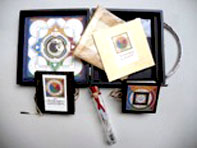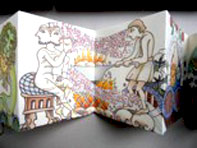Deconstructing Elsie
Deconstructing Elsie
Deconstructing Elsie
Box containing three books (concertina fold, tulip fold, and pamphlet sewn), packet of seeds, and test tube. Pen and colored inks. Inkjet printed. Other materials: glass, ribbon, cork. Concertina: double sided, 4 x 4.5" closed; 16 pages and 14 pages; ribbon closure; signed and dated by the artist. Tulip fold: 3.5 x 3.5"; 6 folds on one side, 4 folds on opposite; ribbon closure. Pamphlet: 1.5 x 5.5"; 8 pages; slipped in waxpaper lunch bag. Wooden box: 8 x 8 x 2" closed; metal clasp closure; handle; metal ornaments at corners; paper title on lid; two compartments. Mari Gower: "The food I put in my body is probably the most intimate ecological issue. I’ve come to understand that organic and natural ingredients are good and anything artificial is bad. With that in mind, the case against GMO [genetically modified organism] crops seems pretty straightforward. But then, I’m looking at this from the perspective of a citizen of a first world country. Like most ecological issues, the debate over GMOs is very complex. For the large percentage of the world’s population – for whom insufficient food is a daily reality – the promise of pest-resistant crops with higher nutritional yield sound more like a dream than a nightmare. I don’t pretend to have answers. To explore these issues, I created An Alchemist’s Lunchbox. I see the biologists working with plant DNA as akin to medieval alchemists, searching for ways to transform base materials. But is the end product true gold or some form of Frankenstein’s monster? I used medieval alchemical texts and botanic illustrations as my inspiration to present several different ways of looking at the outcome." Mari Gower, blog: "I liked the idea of assembling a lunchbox – as if my imaginary alchemist is constructing a meal from his/her experiments. I've used the ancient alchemical device of the division of the four elements (fire, water, earth & air) as a theme throughout the components of the piece. "The box contains: a test tube, an accordion fold book, a tulip fold book, a packet of seeds, and a pamphlet stitch book in a waxpaper lunch bag." "Inside the lid is an expanded painting of the Four Elements diagram with another common alchemical image, the Ouroboros (the dragon biting its own tail; symbolizing a constant state of destruction & creation), in the center. In each corner is a quote from famous alchemists. "The test tube contains dried flower petals, seeds, and the most famous quotes from The Emerald Tablet: 'That which is above corresponds to that which is below' and 'That which is below corresponds to that which is above.' The idea of balance was so important that many Medieval Alchemists posted copies of this text in their workshops as a reminder of the basic principles of their art. I think the concept is even more important today, as we learn more about the far reaching effects of our endeavors. I hope modern scientists consider the importance of balance and consequence in whatever experiment they begin. "The Accordion fold book, 'An Alchemist's Lunchbox,' begins with a famous alchemical allegory: the green lion devouring the sun. Alchemists were fond of using such imagery to hide the formulas in their experiments. As an artist, I find these images far more poetic than: 'use a mixture of nitric and sulfuric acid to dissolve gold.' "The book continues with a quote from Shakespeare's A Midsummer's Night Dream, which, to my mind, seems to sum up the Alchemist's quest. The image is inspired by a decoration in an illuminated manuscript showing Janus, the two-faced god, blowing a glass beaker while a servant tends a pot over a fire. "On the reverse side of the panels, I've collected quotes from current experts from both sides of the GMO debate. "The remainder of the book shows symbolic representations of the alchemic process alternating with the most common GMO crops along with pests that often prey upon crops. The plants represented are cotton, corn, canola and papaya. "Another component of the lunchbox is a tulip-fold book entitled, 'Side Dishes.' I was inspired by antique botanic illustrations. So in this piece I played with the idea of Frankensteinian fruits and vegetables. Once again I used the crops that are most common genetically modified at this time. "In the waxpaper lunch bag is a pamphlet stitched booklet of 5 poems, which I have written to express some of my feelings about the issues I've explored in this piece." A portion of the artist's proceeds will be donated to the PCC Farmland Trust, which helps preserve organic farmland. |

